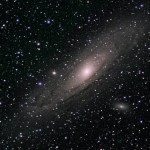dwarf
"If you are writing any book about the end of the world, what you are really writing about is what's worth saving about it." -Justin Cronin
Well, it's Friday again, and that means it's time to dip into the question/suggestion box, and see what you've come up with for me. This week's Ask Ethan comes from our reader Michael Acosta, who wants to know about the end of the world. Not, mind you, the way the world is actually likely to end, but in a way that would be satisfying to an aspiring science fiction writer.
In this wonderful science fiction book I am writing, there is a subplot involving…
Continuing our long tradition of espousing the virtues of dwarfism and breeding animals as tiny as possible regardless of the health consequences (i.e. adorability!), we bring you a contender for world's smallest horse. This thing should be painted pink or lavender immediately!
Ahh, stars. Giant furnaces of nuclear fusion. Doing the stuff our Sun does, burning hydrogen fuel into helium (among other things) and emitting lots of visible light and energy in the process.
But when we take a look at brown dwarfs, they aren't like normal (i.e., main sequence) stars like our Sun. Instead of burning hydrogen into helium for their fuel, brown dwarfs don't generate enough pressure to make that happen; they can only burn hydrogen into deuterium.
Let's go over what the differences here are. A hydrogen nucleus is just a proton, with a mass of 938.272 MeV/c2. (I use these units…
Last week, Jamie (my significant other) came home from work and told me about a conversation she had with her coworker, Chris. This week she asked another one, Miguel, whether he had any questions about Astronomy, Physics, space, etc. This week's question comes from Miguel:
What is a galaxy, anyway? Why does it look like a big bright fuzzy star? And why are there different types of galaxies; shouldn't they all be the same?
This might come as a surprise, but 100 years ago, it was pretty much accepted that we were the only galaxy in the Universe. In fact, there was a great debate in 1920 on…


